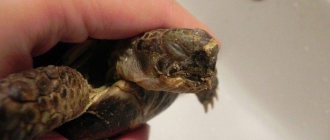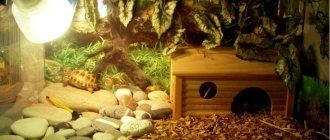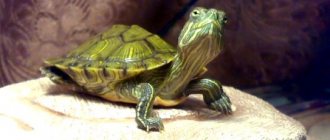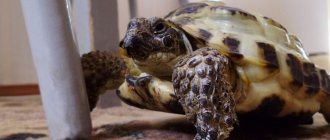How and how long do turtles sleep?
A turtle is a rather interesting pet for the home, which has its own advantages and is very unusual for living conditions in our country. But before getting a reptile, you need to learn about all the principles and rules of keeping the animal in order to provide it with quality conditions. One of the important points is the turtle's sleep, and it is not the same as other animals. Turtles rest in a very unusual way, so in this article you will learn about how and how much reptiles sleep, what features can be found in such a seemingly ordinary process. Hibernation For example, red-eared turtles hibernate in winter, which can last about 5 months. Why is this necessary? In winter, the air temperature becomes significantly lower, which causes all processes in the pet’s body to slow down. It is worth noting that throughout the entire 5 months the animal practically does not breathe, which can frighten an inexperienced breeder. As for nutrition, it is provided by accumulated fats in the body. Due to the reptile's zero activity, calorie consumption occurs incredibly slowly, and they last throughout hibernation. They also support all the vital functions of the body. If you have already become wary that your pet will fall asleep for almost six months, then you can relax. At home, hibernation is not at all necessary for an animal, since there will be no drop in temperature in the room as such. To create special conditions for an animal, you need to seriously try. First, the turtle must be deprived of any kind of food for a whole week, after which it must be placed in damp moss, and the temperature around the reptile must be gradually lowered. In artificially created conditions for hibernation, the turtle will sleep for about 3 months. The mark of 5 months is the maximum, and it is typical for hibernation in the wild. Do pet turtles even sleep? Many owners could observe that their pet does not show much activity during the day, but at night he is full of energy and is ready to frolic for almost several hours in a row. Well, this is one of the first features of such pets. Absolutely all turtles sleep, but their sleep can occur both during the day and at night. For example, if you work and leave the turtle alone all day, it will prefer to sleep, because nothing from the outside will disturb it. When the owner arrives, she begins to frolic because she feels that she is not alone in the house. As for the place of sleep, reptiles can sleep both in water and on land, but the latter option is more preferable for almost every individual and species. What does a turtle's sleep depend on? The answer is extremely simple. The fact is that a turtle's sleep is proportional to its daily activity. If your pet is absolutely inactive, then he will need little time to sleep. In the case when the turtle plays with you all day, frolics, constantly runs around the room or swims in the aquarium, it will need much more sleep in order to restore its vital energy. Another factor that influences how long a turtle sleeps is its gender. But determining the sex of your pet is quite difficult, since only a few factors can indicate gender. The last factor is the presence of diseases, if any. When an active animal suddenly begins to sleep for a large amount of time, you should immediately seek professional help, since high sleepiness can be a signal for the formation of serious illnesses that can completely kill the pet.
If your turtle sleeps too long or too little
In this case, you just need to observe the behavior of the animal. If the pet eats well, swims actively, communicates with other neighbors in the aquarium, i.e. behaves as usual, her health is safe. Typically, such periods of instability end after a few weeks, after which red-eared turtles spend the night in their usual rhythm.
If your reptile sleeps very little and is too active, it should be taken to the veterinarian. He will be able to clarify the reason for this behavior and prescribe sedatives and other medications. If turtles sleep a lot, literally for several days in a row, but wake up, feed, swim and fall asleep again, this is quite normal. If a sleeping turtle is not active at all, this may indicate the beginning of the development of the disease.
The only exceptions are those cases when the animal has gone into hibernation. This usually happens during the autumn-winter season, provided that the owner specially prepares the pet. To do this, reduce the temperature in the aquarium for several days in a row, significantly reduce portions or do not feed the turtle at all, etc.
In wild nature
Of course, a turtle, like any living organism, needs sleep and rest. And since she leads a rather extraordinary lifestyle, sleep, which seems like an ordinary thing, has its own cute characteristics. Thus, land turtles, which include two subspecies, sleep completely differently, based on their habitat conditions:
Freshwater turtle
A freshwater turtle sleeps in the depths at night. Under natural conditions, it is active during the daytime. During the day it basks in the sun, absorbing heat and traveling on land, occasionally plunging into water. At night it sinks to the bottom of the reservoir and sleeps until sunrise.
Pet turtle sleep
How do turtles sleep at home? Living next to a person, the behavior of the reptile has changed somewhat. You no longer need to run away from all paws or hide in a shell in case of danger and get yourself food every now and then. However, the underlying instincts still work:
- Evening rest of the red-eared friend. The red-eared turtle, like the wild species, prefers to stay awake during the day, occasionally interrupting to doze under a heating lamp, and to rest at night, sinking to the bottom of the terrarium, provided there is enough oxygen in the lungs. The absence of sources of threat to life calms the pet, and the reptile can fall asleep on land, hiding in its shell.
- The land turtle also adheres to the natural regime. The peak of activity occurs in the early morning and late afternoon, and they go to bed twice, during the day and at night, buried in the bedding.
The more active the pet, the deeper and longer the sleep. If the animal sleeps for a long time, but does not refuse food during the short period of awakening, there is nothing to worry about; perhaps it is due to the individual characteristics of the body. If sleep is short and intermittent, the reptile must be shown to a doctor to prescribe medications that reduce the anxiety threshold.
How much sleep do they sleep per day?
If we consider the sleep and wakefulness regime in general, then there is no special routine. It all depends on the specific type of pet and its personal preferences. In addition, the duration and frequency of sleep are influenced by the following reasons:
Pet's age. The older the individual, the more time it takes to rest.
In a dream, the sick turtle regains its strength. External indoor environment. The absence of an owner and irritating factors encourages sound sleep. Conversely, the presence of the owner or other pets encourages prolonged activity.
Diseases. For a weakened individual, long sleep is restorative. If the turtle has become lethargic and often becomes drowsy, it is necessary to show it to a specialist.
In short, everything depends, first of all, on the turtle itself and the degree of active load. Walking outside, long swimming, climbing slopes and slides consume a lot of energy, therefore, the more often your pet is awake, the more soundly and often he sleeps.
Factors affecting red-eared slider sleep
The first factor affecting a reptile's sleep is its activity level. The duration of sleep depends on how active the pet is. If the turtle doesn't move much, it won't sleep very long. But with a very active lifestyle and great mobility, the reptile will succumb to sleep for a longer time.
Another factor is the gender of the reptile. It is impossible to distinguish between individuals at a small age, and no one can do this. The sex of a turtle can be determined at a later age. It is necessary to compare the length of the tail of individuals, since the male will have it longer, as well as the length of the claws, which will also exceed the females in importance.
Sometimes, during the occurrence of certain types of diseases, the turtle’s life cycle is disrupted, and in turn can cause very long sleep, or, conversely, its complete absence.
It is impossible to say exactly how long turtles sleep when kept at home. Since a reptile’s sleep directly depends on the created living conditions, as well as on the character of the individual itself.
Do turtles sleep in winter?
Hibernation for turtles is a kind of adaptive technique that helps them survive during changing seasons and falling temperatures. In addition, in order to maintain health and reproductive abilities, hibernation helps to survive the shortening of daylight hours and the lack of water and food. Under natural conditions, hibernation is characteristic of some species of land turtles:
- Mediterranean with a spur on the hip.
- Herman's tortoise.
- Serrated.
- Central Asian.
When the necessary conditions are created in captivity, which are as close to natural as possible, these species wait out the winter in a state of suspended animation.
Species that stay awake include the Egyptian, African spurred tortoise, panther, Tunisian, Indian star and quinix tortoises.
Forcing a reptile into hibernation, which does not sleep in the wild, leads to the death of the animal.
In addition, under the created conditions, with the presence of a sufficient amount of ultraviolet radiation, heat, water and food, hibernation is not necessary for domestic turtles. If the reptile is ready to spend the winter, its behavior will change. The first signs are a decrease in appetite and activity.
How to properly bring a turtle out of hibernation
In order to properly remove an animal from wintering, it is worth performing all of the above steps, only in reverse order. It is necessary to initially increase the temperature in the room, then carry out digging procedures and only then offer the animal food and water. Ideally, red-eared turtles emerge from hibernation five days after they begin to awaken.
If after the specified time no changes in the pet’s condition have occurred, you should definitely seek help from a veterinarian, who will recommend how to correctly carry out this process without losses to the animal’s body.
Under natural conditions, leaving hibernation is a normal process that goes away on its own, but at home it is quite difficult to wake up a reptile. It is also worth noting that a sufficiently large number may die after entering hibernation due to various diseases and sufficiently weakened immunity.
If you are a conscientious owner and take proper care of your pet’s health, namely, nourish his body on time with vitamins and microelements, and also organize proper nutrition for him, then the wintering regime will pass without consequences, and the animal will only regain its strength for the entire next year.
Motives for long sleep
A considerable number of lovers often wonder why the turtle sleeps all the time? What are the reasons for such a long dream? The reasons for long sleep are:
A change of scenery. The cause of stress is not only moving to a new home, but also moving the terrarium to another room. During the adaptation period, which lasts a couple of weeks, the pet will get used to it and become active again.
In winter, install additional lighting.
Reducing daylight hours. With the onset of autumn, the days become shorter, the reptile reacts to the reduction in natural light.
The situation can be changed by installing additional lighting that will maintain the required day length. Temperature in the terrarium. Elevated temperatures provoke forced cooling of the body, forcing the animal to climb into the ground or water. Reduced - automatically prepares the turtle for hibernation. By setting a constant, optimal temperature for the turtle from +26 to +33°, the pet’s condition is leveled out.
It is worth noting that the reptile sleeps quite often and for a long time, especially after a hearty lunch. But if this worries the owner, consultation with a herpetologist is necessary.
How to tell if a turtle is sick or hibernating
As a rule, turtles kept in apartments do not need long hibernation. With the onset of seasonal cold, in October-November, the inhabitant of the aquarium may slightly change her behavior. She loses her appetite and sleep duration increases. But she is unlikely to hibernate, since the apartment is quite warm and light, and her own “home” is also additionally illuminated.
On the other hand, the behavior of a turtle, which its owners regard as hibernation, can be a dangerous and sometimes fatal disease. Therefore, if the apartment is warm, but the turtle is sleeping and not moving, you should sound the alarm. The first thing you need to do is touch it: if the head and limbs are extended and do not respond to touch, it is likely that the pet has died. When a living turtle gets into warm water, it will definitely begin to move its legs and try to swim. Another sure way to determine if a turtle is alive is to check the corneal reflex. If the eye does not react to the touch of any object, then the turtle has died.
Characteristics of the species "red-eared turtles"
The length of a red-eared turtle is measured by its shell; usually in natural conditions these figures can reach up to thirty centimeters in length. However, it is worth noting the fact that these indicators are typical for those individuals that live in the wild, but at home they are achieved quite rarely, almost never. Female red-eared turtles can be significantly larger than males. The characteristic color of the shell is green, which is distinguished by its characteristic brightness, indicated by bright yellow patterned stripes.
Parts of the body such as the head, neck and paws of the reptile are indicated by a series of stripes of white and black. This species received the name “red-eared turtle” due to the characteristic red spots that are located near the animal’s eyes. In veterinary medicine, these spots are called ears. However, it is worth noting that the color variety of these circles can vary from yellow to dark orange. Due to the fact that the external features of these reptiles are quite bright and ambiguous, these animals are very popular among domestic breeders.
Representatives of this type of reptile are quite sedentary, but they are able to swim quite quickly. Also, this type of turtle is quite curious and constantly tries to discover something new.
If the animal feels any anxiety, it may begin to make hissing or snorting sounds. If the danger is really serious, then the animal is able to fully protect itself by inflicting fairly deep wounds with the claws of its hind paws. In winter, you can observe a phenomenon that is characteristic of almost all varieties of turtles - this is hibernation, or in other words, suspended animation.
How long does the red ear live and where does it live?
This type of turtle can rightfully be considered a long-liver. In favorable conditions, life expectancy is 40 years. An interesting fact is that the red-eared turtle has a high level of intelligence, not typical of other reptiles. These animals are very sensitive to vibrations and their behavior can warn of an impending earthquake or storm. When choosing food, the red-eared turtle first focuses on the color, and only then on the smell and taste of the object.
These reptiles are widespread in nature. They can be found in their natural environment in Central and South America, Israel, South Africa, Spain and even Great Britain. But in Australia, this species is officially recognized as a pest, since it destroys local endemics. The red ear lives in shallow ponds and lakes, and in other bodies of water with swampy shores.
Hibernation of red-eared turtles
The question of how red-eared turtles sleep at home arises for almost every breeder. This is due to the fact that in nature, turtles fall into a sleep mode in accordance with temperature changes and the season of the year, but as for home conditions, it is worth following some norms and principles in order to properly organize this phenomenon.
Basically, when keeping a turtle in artificial conditions, the phenomenon of hibernation is not a prerequisite for keeping red-eared reptiles, however, it is worth noting that the animal can independently fall asleep due to the fact that the temperature in the room is either too high or too high. low. In this way, the reptile seems to save itself from extreme heat or cold. If a turtle's diet is not sufficiently balanced, it may simply go to bed due to a characteristic lack of food.
Turtle hibernation in winter
In their natural environment, when the air temperature drops, turtles need to hibernate. By making some observations of a reptile in the wild, you can accurately determine the duration of its sleep. Based on this information, you can understand how much red-eared turtles sleep at home, however, when creating comfortable conditions for the reptile to live in, the turtle does not need hibernation in captivity.
In nature, a turtle can sleep for five months, while its breathing is practically not carried out. The processes that occur in the reptile’s body slow down, and the life cycle is maintained with the help of fat, which the reptile accumulated during the active period of the year. However, when kept at home, it is highly not recommended to create conditions under which the turtle will hibernate.
Remember! A pet turtle does not need to hibernate every year and will feel better staying awake all year.
If for some reason it is necessary to hibernate a domestic reptile, this should be done gradually and following certain rules. The process of preparing a pet for hibernation involves certain preparations, namely:
- you need to not give the turtle food for a month,
- plant it in moss of a certain humidity,
- create a gradual decrease in temperature and a decrease in daylight hours.
In most cases, a turtle's sleep at home lasts no more than three months.
How to properly arrange a place to sleep
When the time for hibernation approaches for red-eared turtles, they begin to behave a little strangely. However, it is worth noting that the approach of this moment can be determined by the following changes that occur in the behavior and condition of the animal:
- The red-eared reptile begins to limit the number of its movements;
- The animal begins to yawn quite often;
- Characteristic clogging into a corner of an aquarium or terrarium. However, it may not show signs of activity at all.
If you notice all these signs in your animal, then first you should consult with a highly qualified veterinarian, who will initially determine what exactly is happening to the animal, and also rule out possible diseases that also have characteristic symptoms. If everything is fine with the animal’s condition, then these signs are precisely symptoms of the approaching wintering of red-eared turtles.
In order for the reptile to enter wintering mode with the least loss to health and during sleep it receives all the necessary nutrients, which in about two months will significantly increase the reptile’s diet. This increase contributes to an increase in body weight, which is a reserve for kicking. It is also worth considering that a reptile can lose almost half of its weight during sleep.
When the penultimate week begins before hibernation, it is worth completely limiting the animal’s diet, and immediately the day before going to bed, it is worth bathing it several times, this is necessary so that the animal can completely empty its intestines, thereby independently preparing itself for sleep.
Cooking the turtle itself is a mandatory process, but it is equally important to properly mark the place where the sleeping resident will spend the winter. Temperature readings should not exceed 6C. The best place for wintering is the basement, which is usually a fairly cold place, but nowadays it is quite difficult to find such cellars. It is necessary to accustom a reptile to these temperature indicators gradually, since a sharp decrease in temperature indicators can lead to the unexpected death of the animal.
The next prerequisite is maintaining the correct humidity level. In the container where the red-eared turtle will sleep, it is necessary to lay natural bedding, ideally it should be moss or peat. This flooring should be constantly moistened, but care must be taken that it is not wet.
If all the conditions necessary for the proper hibernation process are carried out correctly, then the animal can remain in sleep mode for three to five months. However, it is worth noting that after the specified time has elapsed, the turtle must be properly taken out of sleep mode.
Keeping at home
Keeping this exotic animal turns out to be much more difficult than initially thought.
These turtles spend most of their time in the water, although they need land. For one adult, an aquaterrarium with a volume of 120-150 liters will be comfortable, while land should occupy no more than 25% of the total area. On the improvised bank, special soil or crushed stone should be poured, making a gentle rise. The turtle's shell must fit completely in the water so that the animal can easily roll over onto its back and back. For this type of amphibian, the optimal temperature is 25-30 degrees Celsius. When the temperature drops to 20 degrees, hibernation may occur in red-eared turtles. The water in the aquarium is changed as needed, at least once a month. In order for the turtle to be healthy, it also needs to be provided with portioned irradiation with an ultraviolet lamp.










